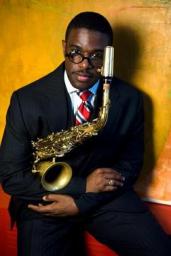There was a brown door in a modest kitchen, scuffed by the onslaught of time, children and life's general maneuvers. It guarded a staircase leading down to a basement, spacious enough and made congenial, such that it was often strewn about with middle-aged men.
When closed, this door allowed a generous amount of space between it and the floor, and was not the most efficient muffler of sound. If one crouched by its bottom, the world it attempted to conceal came spilling forth like the secrets of some giddy deluge.
On many evenings in the 1980s, a child's face poised at this small expanse took in wonders it did not fully understand. An aural kaleidoscope of sorts, screeching horns, wailing guitars, frenetic drums and melodic keyboard washes, exclamations of joy, occasional shouts of discord, smoky smells and serious discussions. It was a scene of freedom, of experimentation, of expression. There seemed to be much euphoria, and yet much frustration over the distillation of some truth.
This, my drummer father's twice-weekly rehearsal for his Chicago jazz band, Night Knights, was my introduction to jazz.
I was ruined. I wanted more. Jazz seemed to me, at a tender age, an uncontrolled force that bubbled up inside its practitioners, taking hold at the root of men's spirits and holding them captive. The gruff grunts between measures and animalistic bellows did not sound like my father during normal hours, nor like his gentle gaggle of friends when they'd emerge from the basement rehearsal space to use the bathroom, me scrambling awkwardly back to the television to avoid discovery. It was as if the music covered their souls with a sinister, yet beguiling, cloth.
I believe the old myth of skilled musicians having sold their souls to the devil for their talents comes from a place of truth: minstrels worth their weight have a seductive quality that — given the right moment, the right venue — seems capable of leading people into damnation at their will.
This seems especially true of improvisational music, such as jazz, where so much relies on a player's intuitive knowledge of the art form on both academic and guttural levels. Jazz is a crazed flight into a sordid, beautiful unknown, and its experience can be liberating.
Forget the "smooth jazz" and the neutered Muzak versions of old classics played in shopping malls; it is still the bebop, "cool jazz," free jazz, post-bop and jazz fusion of yore that define the genre's greatness. Burning with a respectful elation, contemporary practitioners are running like deranged banshees with the torches they've been handed.
One such practitioner is bebop saxophone virtuoso Antonio Hart of Brooklyn. He brings the Antonio Hart Quintet to the Vermont Jazz Center in Brattleboro at 8 p.m. Saturday.
Hart has recorded and toured internationally with such notables as Dizzy Gillespie, Roy Hargrove, Jimmy Heath, Nat Adderley and McCoy Tyner. Starting off playing classical, he began to feel "more of a connection with jazz because of the people he saw playing it and the chance to improvise," as he states in his official bio.
He attended Baltimore School for the Performing Arts after his inner-city high school cut funding for music education. He then attended Berklee School of Music. There he met and toured with Hargrove for three years, also recording Hargrove's first three albums with him. Hargrove collaborated with Hart on Hart's debut recording, "For the First Time."
Hart's 1997 release, "Here I Stand," earned a Grammy nomination for Best Jazz Instrumental Solo. Combined with fronting his own quintet, he acts as professor at The Aaron Copland School of Music at Queens College (where VJC president Howard Brofsky serves as professor emeritus), and travels with The Dizzy Gillespie All-Star Big Band and The Dave Holland Big Band.
Hart's old-school, upbeat, jerky yet fluid, dissonant yet radiant brand of jazz is solidly bebop. Bebop, or simply "bop," came about in the 1940s as an attempt to move jazz from its danceable, popular, swing and ragtime origins into the realm of true "musician's music," into a more challenging musical expression combining elements of the avant-garde and heavy improvisation.
More adventurous 1930s-era soloists, pianists Art Tatum and Earl Hines among them, inspired young originators such as Gillespie, Charlie Parker and Thelonious Monk.
The fast tempo and psychedelic experimentation of bebop was born, and subsequent practitioners such as drummer Art Blakey and his band The Jazz Messengers followed suit. It was a revolution within an already revolutionary form of instrumental music.
The changes, energy and flow in many Hart compositions are personally expressive, while acting as elegiac odes to their forebears. "Down and Up" owns a wild-man bop kinesis, while "Imagination" showcases a nimbleness on the sax and willingness to explore the outer reaches of his instrument's capability, replete with a pleasing drum jam toward the end. "Auditory Illusion," meanwhile, has thoroughly discordant harmonies and angular melodic twists forming a sonic labyrinth.
Hart's one downfall may be his occasional tendency to dip into Christian blandness, with uninspired gospel vocalists and subdued melodies revealing his religious proclivities. At these times, the smoky '40s jazz club feeling dissipates.
All told, Hart is a thoroughly expressive jazz cat, and not one to be missed. The genre soldiers on.
--------
This article originally appeared in the Rutland Herald newspaper.
--------

Post new comment